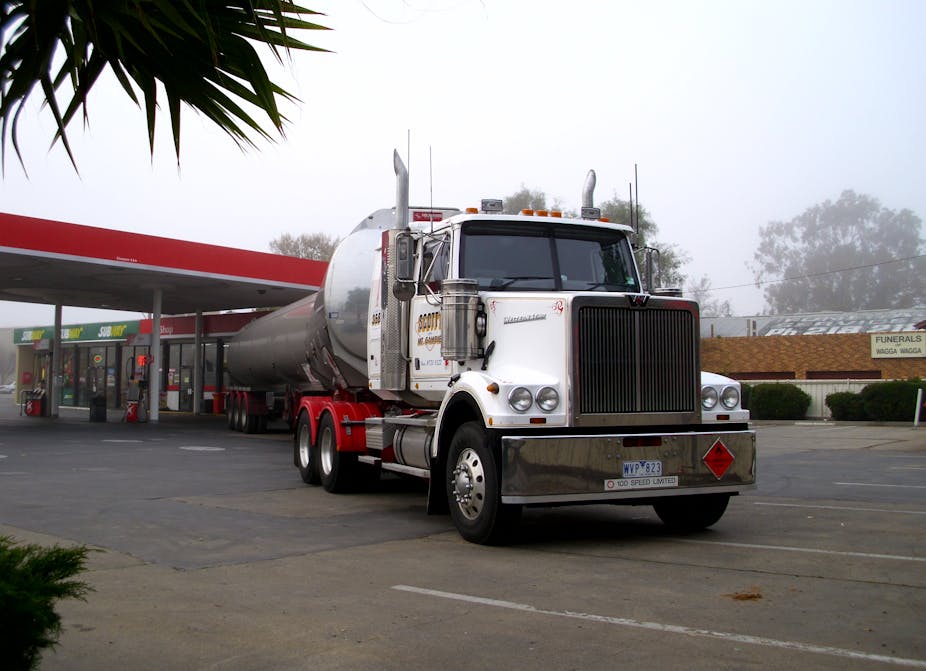It might sound unlikely, but Australia’s fuel gauge is worryingly low. We’re one of the world’s top energy exporters, but our stocks of liquid fuels – such as the oil on which almost the whole transport sector depends – are far from healthy.
Australia’s worsening liquid fuel security problem was detailed this week in the latest instalment of a report prepared for the National Roads and Motorists’ Association.
A year after the issue was first raised, there has been no action to address the growing risks, both logistical and financial, of keeping so little fuel in the tank.
Lack of refinement
According to the report, refinery closures coupled with growing demand for petroleum have increased Australia’s dependency on imported refined petroleum products. As a result, oil-dependent sectors such as transport, mining and agriculture are vulnerable to supply-chain interruptions or future oil-price spikes.
The situation is made worse by the fact that Australia is consistently the only International Energy Agency (IEA) member state that fails to maintain the mandated stockpile of 90 days’ worth of net oil imports. Australia’s stockpiles stood at 57 days as of November 2013. The NRMA report estimates Australia’s in-country stockpile, which excludes shipments en route to Australia, at only 23 days.
With growing demand for liquid fuels and a continued “hands-off” approach from government, by 2030 Australia is on track to find itself with no refining capacity, less than 20 days’ worth of liquid fuel stocks, and entirely at the mercy of the international oil market.
The report’s author, retired Air Vice-Marshall John Blackburn, has called on the government to step in. This year’s National Energy Security Assessment and Energy White Paper both offer opportunities for public debate. The report also suggests making fuel stocks a matter of national security risk analysis.
Hurting the hip pocket
Relying on imported oil isn’t just risky – it’s expensive too. In 2012, Australia’s net oil imports were 561,000 barrels per day. At an average of US$109.08 a barrel for that year, the bill was US$22.3 billion, or 1.7% of Australia’s gross domestic product.
At the same time, there are fears of a slowdown in Australia’s mineral export revenues as China’s economy loses pace.

The government seems to be refusing to consider the potential threats to Australia’s coal, liquid natural gas (LNG) and other mineral exports. Australian LNG, for example, costs more than its competitors in North America and Africa – and Australia’s customers in Asia are increasingly critical of the prices they are being charged. Without giving any consideration to potential threats to Australia’s market share in Asia, industry minister Ian MacFarlane has hailed forecasts that assume a continued increase in energy export revenues.
The back story
Australia’s complacency over oil imports can be traced back to the discovery in the mid-1960s of oil in Bass Strait. While not large by world standards, these reserves increased Australia’s oil self-sufficiency from 10% to 70% in the years leading up to the 1973 oil crisis, when world prices rose sharply.
Four decades later the picture is very different, although people don’t necessarily know it. Blinded by positive headlines about energy exports, only 1% of Australians consider the energy crisis, petrol prices and fossil-fuel supplies to be our most pressing issue.
Perhaps Australia’s good fortune during the 1970s has helped to entrench a free-market approach to the oil market, while other nations that were more badly burned by OPEC’s price-gouging have taken stronger steps towards oil independence.
The Hawke government’s free-market attitude continued through the Howard years, as evidenced in Australia’s first ever Energy White Paper. Released in 2004, it openly acknowledged Australia’s oil deficit. But instead of raising the issue as a significant energy security threat, it sought to reassure by pointing to surpluses in gas, uranium and coal. The policy implication was clear: as long as Australia remained a net energy exporter, its liquid fuel balance was nothing to worry about.
None of this changed with Labor’s return to power. The 2012 Energy White Paper also struck a positive tone, based on Australia’s position as an energy producer and net exporter, which implied overall energy security. And now the Abbott government, in preparing this year’s Energy White Paper, seems to consider the international oil market so resilient that the supply of crude oil and refined petroleum to Australia is guaranteed. However, it is worth noting that its recent issues paper includes a reference to asking whether Australia needs to increase its stockpiles to meet international obligations.
Real impacts
Energy security issues may impact ordinary Australians directly through high consumer prices, fuel shortages and the environmental impacts associated with energy consumption. Given the importance of energy to the Australian economy, it is vital that the government reevaluates its approach to energy policy and engages in a systematic risk analysis regarding both Australia’s growing liquid fuel import dependency and potential threats to demand for its energy exports.
While Australia remains faithful to the basic principles of free-market economics, if they are wrong the consequences could be dire. A bipartisan “hands-off” approach and general public complacency regarding Australia’s energy future may not serve the nation’s best interest in the long term.
In terms of practical solutions to our growing liquid fuels import dependency, meeting the IEA’s mandated stockpile levels would be a first step in the right direction. The government should also consider measures aimed at curbing the demand for liquid fuels in Australia. These might include higher fuel-efficiency standards, improving public transport infrastructure, promoting carpooling, or introducing congestion charges in the CBDs of major cities.

